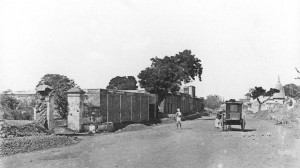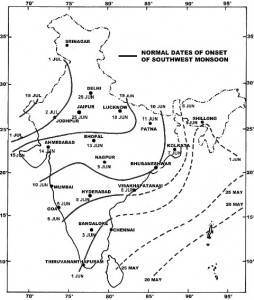
And back I come again
To the baked and blistered ground
And the dust-encumbered plain
And the bare hot-weather trees
And the Trunk Road’s aching white;
Oh, land of little ease!
Oh, land of strange delight!
From the diary of a member of the British Army Engineers, walking from Calcutta to Delhi, conducting the Grand Trunk Route Survey, 1830
Monsoon traditionally sets foot in India towards the second half of May sending fleeting sprinklers over southerly Kerala. The sheeting downpour takes another fortnight; almost unerringly on June 1 (this year though, it was delayed by four days). Before the days of satellite imagery, the Meteorological Centre in the capital city Trivandrum used to hog a lot of national media interest. Built by a scientific-minded Maharaja Swathi Thirunal in 1836, the employees, standing on the verandas, used to observe the monsoon’s billowy approach through telescopes. Even today, this centre is relied on by local and national media to ‘declare’ the monsoon. There used to be a wave of calls from the national capital Delhi, to check whether the monsoon was on time. In a country where the majority of livelihoods are agrarian-based, rains undoubtedly hold the reins to political power.

Now for the complicated bit. The monsoon has two branches – the Arabian Sea branch and the Bay of Bengal one. The one that hits the southern shore is the Arabian Sea one which blows towards the Western Ghats and wrings most of its drippy clouds dry leaving little for the rest of the country as it flows on. The Bay of Bengal branch sets in almost around the same time the Arabian Sea one reaches Kerala’s coasts, hitting the wettest place on earth – Cherrapunjee. But from here, it is turned west by the Himalayas and falls over the Gangetic Plain. These two currents eventually join hands as they traverse over Delhi to become one; leaving the Met department sleuthing over which one will be bringing the rains. Besides the land staying warmer than the sea, there are a host of other factors which affects the monsoon. And this indeed complicates the equations all the more. Like the warming of the Tibetan Plateau in spring. The trade winds from the Southern hemisphere. Like the winds crossing the Equator bent right by the Coriolis force. Several jet streams especially the Somali jet which transits Kenya and Somalia and heads for India. And so they go helping you understand better all the ambiguity surrounding Met forecasts. And the ‘safety valves’ the predictions come with.

Making matters further worse for Met is the El Nino which is expected to make an appearance this year. The last time El Nino struck was in 2009 which coincided with the worst monsoon in the country in four decades. The lil lad is bringing company this year.
Talim.
(All images are courtesy of Google)




